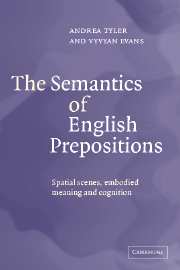Book contents
- Frontmatter
- Content
- Preface
- Acknowledgements
- 1 The nature of meaning
- 2 Embodied meaning and spatial experience
- 3 Towards a model of principled polysemy: spatial scenes and conceptualization
- 4 The semantic network for over
- 5 The vertical axis
- 6 Spatial particles of orientation
- 7 Bounded landmarks
- 8 Conclusion
- References
- Index
5 - The vertical axis
Published online by Cambridge University Press: 22 September 2009
- Frontmatter
- Content
- Preface
- Acknowledgements
- 1 The nature of meaning
- 2 Embodied meaning and spatial experience
- 3 Towards a model of principled polysemy: spatial scenes and conceptualization
- 4 The semantic network for over
- 5 The vertical axis
- 6 Spatial particles of orientation
- 7 Bounded landmarks
- 8 Conclusion
- References
- Index
Summary
In this chapter we will consider three additional spatial particles that involve verticality – above, under and below. The analysis of spatial scenes related to these forms, in conjunction with over, will demonstrate that this subset of spatial particles acts as a particular lexical contrast set. Hence, in semantic terms, the four English lexemes over, above, under and below represent a systematic means of dividing up the vertical axis into four distinct spatial locations. Moreover, the analysis for each of these forms provides further evidence for our representation of proto-scenes for English spatial particles as most appropriately being characterized as involving both a functional component and a conceptual-spatial configuration between a TR and a LM. Our goal, then, in this chapter is to show that working out an appropriate analysis of the distinction between the proto-scenes associated with over versus above and under versus below underscores the efficacy of the model developed in the first four chapters.
Contrast sets
Linguists have long recognized that languages readily add new lexical items to the existing inventory of certain classes of words (open-class words), while being more resistant to adding a new lexical item to the existing set of other classes of words (closed-class words). We argued in chapter 3 that spatial particles represent a closed class of lexemes. They have this status because, in their spatial-physical uses, spatial particles operate within a stable, self-contained conceptual domain (Talmy, 2000).
- Type
- Chapter
- Information
- The Semantics of English PrepositionsSpatial Scenes, Embodied Meaning, and Cognition, pp. 107 - 131Publisher: Cambridge University PressPrint publication year: 2003
- 1
- Cited by



